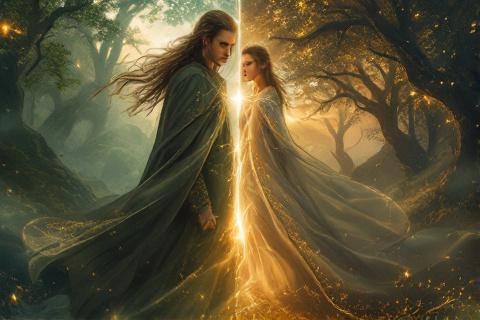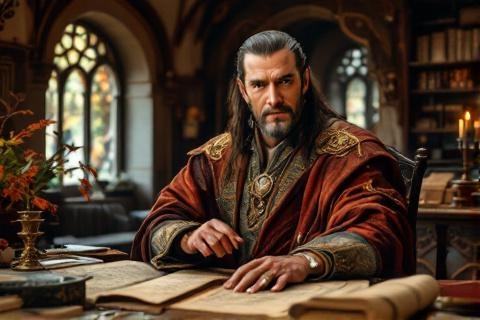
Half-Elves of Middle-earth: Bridging Light and Shadow
Exploring the Legacy, Choices, and Mysteries of Tolkien's Most Enigmatic Lineages
The Origins of Half-Elven Lineages

The tale of Beren and Lúthien stands as the first
and most renowned union between the races of Elves and
Men in Middle-earth's history. In the First
Age, the mortal man Beren fell in love with
Lúthien Tinúviel, daughter of the Elven-king
Thingol and the Maia Melian, creating a lineage that would
forever change the fate of both races. Their legendary quest to retrieve a
Silmaril from Morgoth's crown,
chronicled in detail in The Silmarillion, proved that the
love between the two races could overcome even the greatest obstacles, including
death itself when Lúthien chose mortality to follow Beren beyond the circles of
the world.
The Valar, recognizing the profound implications of unions
between Elves and Men, granted a unique gift to those of mixed heritage: the
ability to choose their fate. This extraordinary privilege allowed Half-elven
individuals to decide whether they would be counted among the Firstborn, with
immortal life bound to Arda, or join the race of Men with the gift of mortality.
This choice, first granted to Eärendil and
Elwing, would become a defining characteristic of their descendants.
Beyond Beren and Lúthien, the First Age saw other significant unions between
Elves and Men, particularly among their descendants. Their son Dior married the
Elf Nimloth, while their granddaughter Elwing married Eärendil, himself
half-elven through his parents Tuor and Idril Celebrindal. These unions
established a complex web of relationships that would significantly influence
the histories of both races throughout the ages of Middle-earth.
The Gift of Choice: Immortality or Mortality

The Valar's blessing to the Half-elven was unique in all of Arda's history,
allowing them to choose which kindred they would belong to permanently. This
gift was first bestowed upon Eärendil and Elwing, following their plea to the
Valar on behalf of both Elves and Men at the end of the First Age. The choice
extended to their children and certain of their descendants, marking them as
distinct from both their parent races.
Once made, the choice between the fate of Elves or Men was irrevocable and
binding, affecting not only the individual but also their future offspring. The
decision carried profound implications: choosing the fate of the Eldar meant
accepting immortality and eventual departure to the Undying
Lands, while choosing the fate of Men meant accepting
mortality and the gift of death, passing beyond the circles of the world.
The most prominent example of this choice manifested in the divergent paths
chosen by the twin sons of Eärendil and Elwing. Elrond chose to be counted among
the Eldar, becoming a lord of great wisdom and power throughout the Second and
Third Ages. His brother Elros chose the fate of Men, becoming the first King of
Númenor and establishing a line of long-lived kings who, while
mortal, far exceeded the usual lifespan of ordinary Men.
Elrond Half-elven: The Wise Lord of Rivendell

As one of the greatest Elf-lords of the Second and Third Ages, Elrond was
entrusted with Vilya, the Ring of Air, mightiest of the Three Elven
Rings made by Celebrimbor. With this ring, he maintained
Rivendell as a sanctuary against the growing darkness, preserving there the
memory and wisdom of the Elder Days. The ring's power allowed him to protect and
heal his realm, making it a lasting stronghold of Elven culture and resistance
against evil throughout the ages.
Elrond established Rivendell, or Imladris, in the year 1697 of the Second
Age as a refuge following the fall of
Eregion. Under his guidance, the valley became a sanctuary for
both Elves and other free peoples of Middle-earth, serving as a center of lore,
healing, and counsel. The Last Homely House East of the Sea, as it became known,
represented a perfect blend of Elrond's dual heritage, welcoming both Elves and
Men while maintaining the highest traditions of both peoples.
Through his marriage to Celebrían, daughter of Celeborn and
Galadriel, Elrond's children inherited an even more
complex heritage, being descended from all three houses of the Eldar, the
Maiar, and the Edain. Their children Elladan,
Elrohir, and Arwen were also granted the choice of the Half-elven, though this
choice would not come without great personal cost to their family, particularly
in the case of Arwen's eventual decision.
The Legacy of Elros: The Kings of Númenor
Following his choice of mortality, Elros became Tar-Minyatur, the first King of
Númenor, establishing a realm that would become the greatest kingdom of Men in
Middle-earth's history. Under his rule, the island kingdom was established as a
gift from the Valar, incorporating the highest achievements and wisdom of both
Elven and Human cultures. His reign marked the beginning of a new age for
mankind, as the Númenóreans grew in power, knowledge, and
sophistication.
The Númenórean kings, through their Half-elven ancestry, were blessed with
lifespans far exceeding those of ordinary Men. Elros himself lived for 500
years, and his descendants continued to enjoy extended lives, though gradually
diminishing over time. This longevity allowed the kings to accumulate vast
knowledge and experience, contributing to Númenor's greatness and the
preservation of ancient lore.
Over generations, the elven characteristics in the royal line gradually
diminished, though their influence remained significant. The later kings of
Númenor lived shorter lives than their ancestors, yet still far exceeded the
lifespan of ordinary Men. This gradual reduction in longevity paralleled
Númenor's growing distance from its original virtues, eventually contributing to
the realm's tragic downfall through pride and the rejection of the Valar's
gifts.
Powers and Attributes of the Half-Elven

Half-elven individuals possessed remarkable wisdom and foresight, inherited from
their Elven ancestors but tempered by their human heritage. This unique
combination allowed them to understand both the long view of the Elves and the
urgent drive of Men, making them exceptional counselors and leaders. Their
wisdom was particularly evident in figures like Elrond, whose counsel was sought
by both Elves and Men throughout the Ages.
The physical appearance of the Half-elven reflected their dual heritage in
fascinating ways. They possessed the characteristic beauty and grace of the
Elves, combined with the strength and vitality of Men. Contemporary
descriptions, particularly of figures like Elrond and his children, emphasize
their Elven-fair features while noting subtle differences that set them apart
from pure-blooded Elves.
Among the most notable characteristics of Half-elven was their remarkable
longevity and resistance to the effects of time and illness. Even those who
chose mortality, like the line of Númenórean kings, exhibited lifespans far
beyond those of ordinary Men. This physical resilience, combined with their
natural grace and strength, made them formidable warriors and leaders, as
demonstrated by figures like Elrond throughout the Ages.
The Tale of Arwen and Aragorn

The love story of Aragorn and Arwen
deliberately paralleled that of their ancestors, Beren and Lúthien, creating a
poetic symmetry in the history of Middle-earth. Like Beren, Aragorn was a mortal
Man who fell in love with an immortal maiden of noble birth, and like Lúthien,
Arwen faced the choice between immortality and a mortal life with her beloved.
Their tale, recorded in the Appendices of The Lord of the
Rings, represents the last great union between the
Eldar and Edain.
Arwen's choice to become mortal for Aragorn's sake echoed Lúthien's decision
millennia before, but carried additional weight as it represented the final
sundering of her family. Her decision meant not only accepting mortality but
also separating forever from her father Elrond and her immortal kin, who would
sail to the Undying Lands. This choice was made with full understanding of its
consequences, knowing she would never again see her father or mother in either
life or death.
The separation of Elrond's family became one of the most poignant examples of
the price of immortality and choice in Tolkien's legendarium. Elrond's departure
to the Undying Lands at the end of the Third Age meant leaving
behind his only daughter, knowing she would share the fate of Men. This final
sundering represented the end of the great Half-elven houses in Middle-earth, as
Arwen's choice meant her children would be counted among Men.
Cultural Impact and Relations
The Half-elven served as natural mediators between the societies of Elves and
Men, understanding intimately the perspectives and needs of both races. Their
unique position allowed them to bridge cultural gaps and facilitate cooperation
between the two kindreds, particularly evident in havens like Rivendell where
both races were welcomed and their traditions honored. This mediating role
proved crucial during major conflicts, especially in the War of the Ring.
Other races in Middle-earth regarded the Half-elven with a mixture of respect,
awe, and curiosity. To Men, they represented a living connection to the
legendary Elder Days, while to Elves, they embodied hope for lasting influence
in Middle-earth even as the power of the Eldar diminished. The
dwarves and hobbits, too, recognized their
unique status, as evidenced by the special respect accorded to Elrond by all
free peoples.
Throughout the Ages, the Half-elven played pivotal roles in nearly every major
historical event in Middle-earth. From Eärendil's voyage to
Valinor that helped end the First Age, to Elrond's role in the
Last Alliance and the War of the Ring, their influence shaped the course of
history. Their unique perspective, combining Elven wisdom with human
determination, made them particularly suited to confronting the great challenges
that faced Middle-earth.
The Fading of the Half-elven

The Fourth Age marked the gradual fading of Half-elven
influence in Middle-earth, as most of the remaining Half-elven departed for the
Undying Lands. Those who had chosen mortality, like Arwen, remained behind but
lived as mortals, their descendants becoming fully human. This diminishing
represented the final stage in the long history of interaction between Elves and
Men in Middle-earth.
The departure of Elrond, along with the bearers of the Three Rings, symbolized
the end of the Elder Days in Middle-earth. This final exodus included many of
the remaining Half-elven who had chosen the fate of the Eldar, leaving
Middle-earth to the dominion of Men. Even Elladan and Elrohir, sons of Elrond,
eventually departed West, though the exact timing of their choice and departure
remains uncertain in Tolkien's writings.
The legacy of the Half-elven endured long after their departure, primarily
through the line of kings restored under Aragorn and Arwen. Their influence
could be seen in the preserved lore, architecture, and wisdom that enriched the
kingdoms of Men in the Fourth Age. The story of their choices and sacrifices
became part of Middle-earth's great tales, serving as a reminder of the unique
bond that once existed between Elves and Men, and the price of the gift of
choice.
